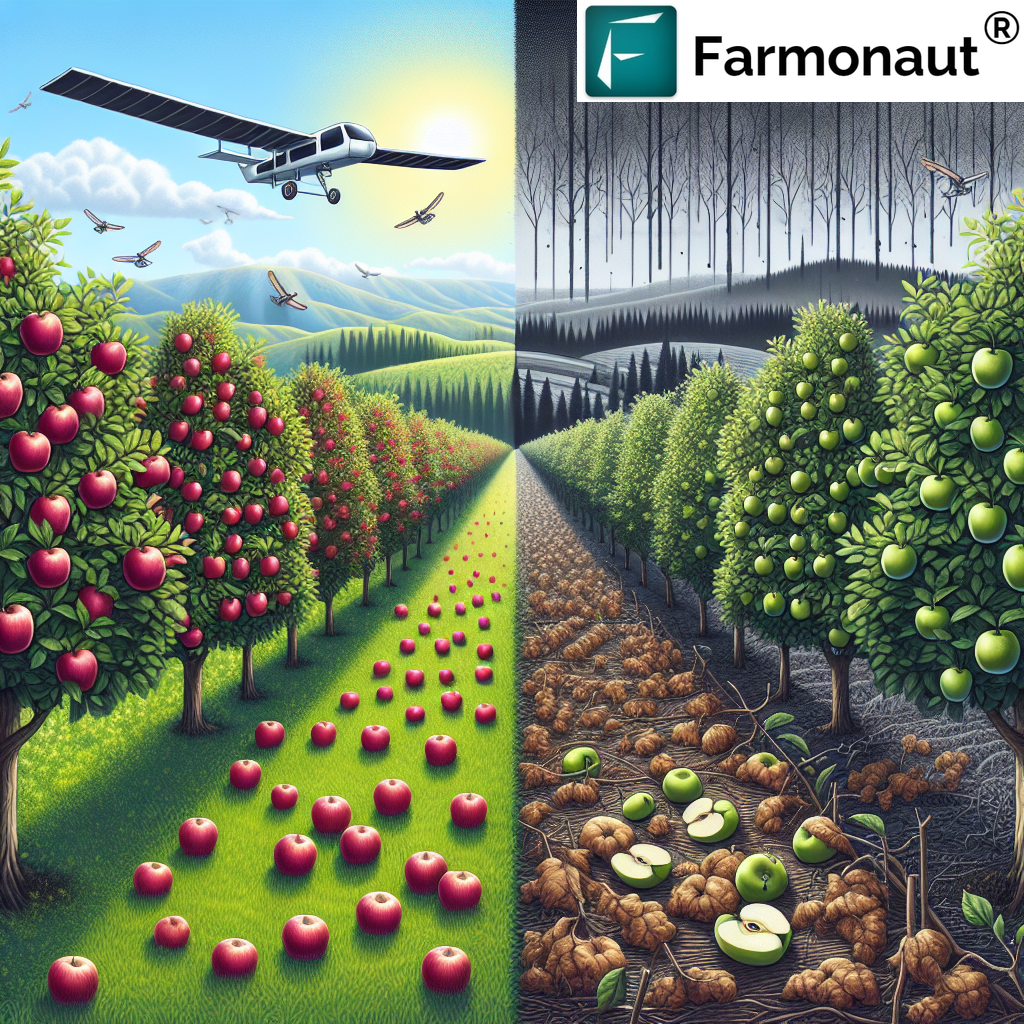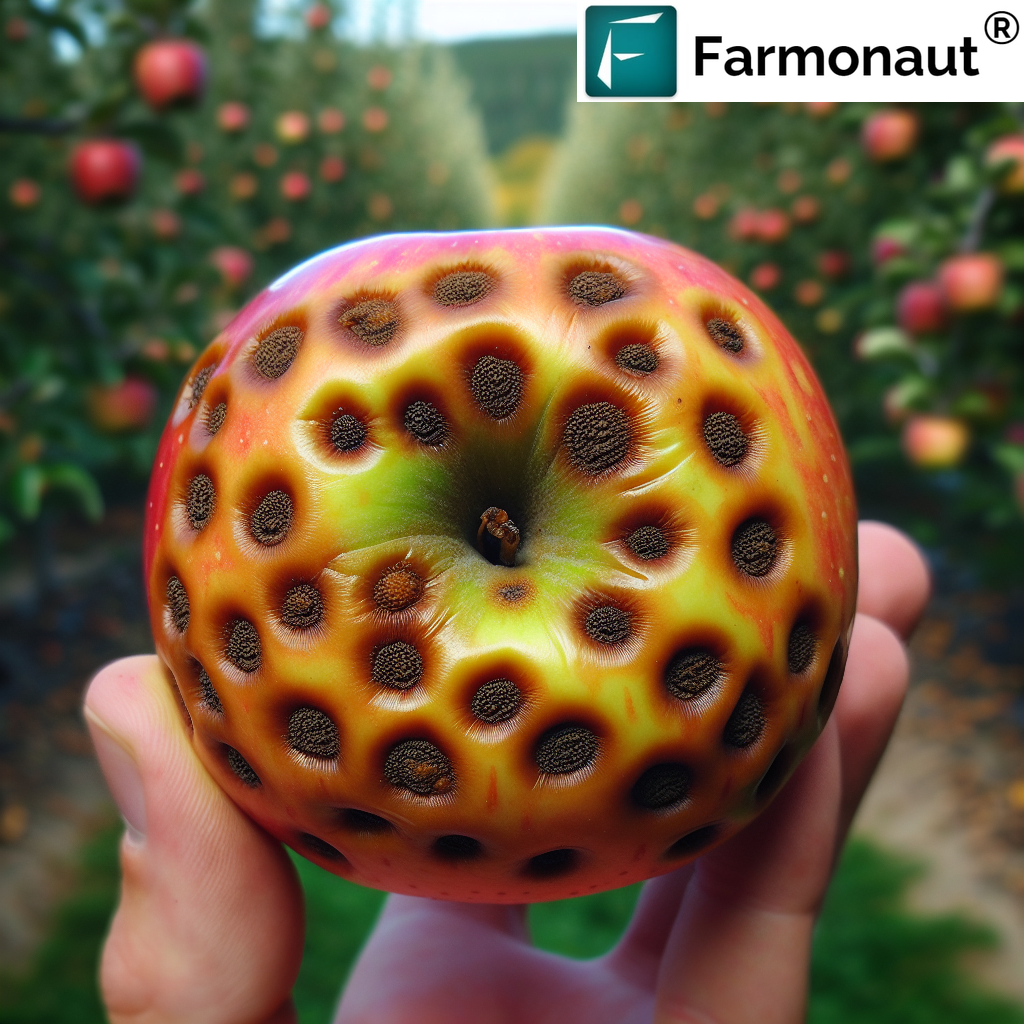Bitter Rot in Apples: Understanding DST Rot and Protecting Your Orchard

As orchard managers and apple growers, we at Farmonaut understand the challenges that come with maintaining healthy fruit trees. One of the most significant issues facing apple orchards today is bitter rot, particularly a strain known as DST rot. In this comprehensive guide, we’ll explore the causes, symptoms, and prevention strategies for bitter rot in apples, with a special focus on DST rot. We’ll also discuss how our advanced satellite-based monitoring system can help you protect your orchard and maximize your yield.
Understanding Bitter Rot in Apples
Bitter rot is a fungal disease that affects apple trees and can cause significant damage to fruit crops. It’s caused by several species of fungi, primarily in the genus Colletotrichum. The disease can occur in all apple-growing regions but is particularly problematic in areas with warm, humid climates.
What is DST Rot?
DST rot, or Deoxy-Septoriose Toxin rot, is a specific type of bitter rot caused by certain strains of Colletotrichum fungi. This variant is particularly concerning due to its ability to produce a toxin that can make the fruit inedible even before visible symptoms appear.
Symptoms of Bitter Rot and DST Rot
- Circular lesions: Small, circular, brown spots on the fruit that gradually enlarge
- Sunken areas: As the disease progresses, the affected areas become sunken
- Concentric rings: Distinct concentric rings often form within the lesions
- Spore masses: Pink or cream-colored spore masses may appear in the center of lesions
- Internal rot: The rot can penetrate deep into the fruit, forming a V-shaped decay
In the case of DST rot, these symptoms may be accompanied by a bitter taste in the fruit, even in areas that appear unaffected.
The Economic Impact of Bitter Rot
Bitter rot, including DST rot, can have a devastating impact on apple orchards. The disease can lead to:
- Significant crop losses, sometimes up to 50% or more in severe cases
- Reduced fruit quality, making apples unsuitable for fresh market sale
- Increased production costs due to the need for fungicide treatments
- Long-term orchard health issues if left unchecked
At Farmonaut, we recognize the serious threat that bitter rot poses to apple growers. That’s why we’ve developed advanced monitoring tools to help detect and manage this disease efficiently.
Preventing Bitter Rot and DST Rot in Your Orchard

Preventing bitter rot, including DST rot, requires a multi-faceted approach. Here are some key strategies we recommend:
1. Orchard Sanitation
Maintaining a clean orchard is crucial in preventing the spread of bitter rot:
- Remove and destroy fallen fruit and pruned branches
- Prune trees to improve air circulation and reduce humidity
- Clean and sanitize tools between uses to prevent spreading the disease
2. Cultural Practices
Proper cultural practices can significantly reduce the risk of bitter rot:
- Choose disease-resistant apple varieties when planting new trees
- Maintain proper tree spacing to ensure good air circulation
- Avoid overhead irrigation, which can increase humidity and spread spores
- Implement proper fertilization practices to maintain tree health
3. Chemical Control
While we always advocate for sustainable farming practices, sometimes chemical control is necessary:
- Apply fungicides preventatively, especially during periods of high risk
- Use a rotation of different fungicide classes to prevent resistance
- Time applications based on weather conditions and fruit development stage
4. Monitoring and Early Detection
Early detection is key to managing bitter rot effectively. This is where Farmonaut’s satellite-based monitoring system comes into play:
- Regular orchard inspections to spot early signs of infection
- Use of our advanced satellite imagery to detect changes in tree health
- Implementing our AI-powered advisory system for personalized management strategies
How Farmonaut’s Satellite System Helps Combat Bitter Rot
At Farmonaut, we’ve developed a state-of-the-art satellite-based monitoring system that offers significant advantages over traditional methods like drone or IoT-based monitoring. Here’s how our system can help you protect your orchard from bitter rot and DST rot:
| Feature | Farmonaut Satellite System | Drone-based Monitoring | IoT-based Monitoring |
|---|---|---|---|
| Coverage Area | Large scale (entire orchard) | Limited by flight time and regulations | Limited by sensor placement |
| Frequency of Data Collection | Regular (every few days) | Depends on manual operation | Continuous but localized |
| Weather Independence | Can operate in most weather conditions | Limited by wind and precipitation | May be affected by extreme weather |
| Data Analysis | Advanced AI and machine learning | Often requires manual interpretation | Limited to sensor data |
| Cost-effectiveness | High (no equipment to maintain) | Moderate (equipment and operator costs) | Variable (depends on sensor network size) |
| Ease of Use | User-friendly app interface | Requires skilled operator | Requires technical setup and maintenance |
Key Benefits of Farmonaut’s System for Bitter Rot Management
- Early Detection: Our satellite imagery can detect subtle changes in tree health before visible symptoms appear, allowing for early intervention against bitter rot.
- Comprehensive Coverage: Unlike spot-checking with drones or localized IoT sensors, our system provides a complete view of your entire orchard.
- AI-Powered Insights: Our Jeevn AI advisory system analyzes satellite data along with weather patterns to provide personalized recommendations for managing bitter rot risk.
- Historical Data Analysis: We can track changes in your orchard over time, helping identify patterns and high-risk areas for bitter rot development.
- Integration with Weather Data: Our system incorporates local weather forecasts to predict periods of high risk for bitter rot, allowing for timely preventative measures.
To learn more about how Farmonaut can help protect your orchard from bitter rot and DST rot, visit our app page or explore our API documentation.
Advanced Techniques for Bitter Rot Management
As we continue to innovate in the field of precision agriculture, we’re exploring advanced techniques for managing bitter rot and DST rot in apple orchards:
1. Predictive Modeling
By combining historical data, current orchard conditions, and weather forecasts, we’re developing predictive models that can forecast the likelihood of bitter rot outbreaks. This allows growers to take preemptive action before the disease takes hold.
2. Targeted Treatment Zones
Our satellite imagery can identify specific areas within an orchard that are at higher risk for bitter rot development. This enables growers to implement targeted treatments, reducing overall fungicide use and improving cost-effectiveness.
3. Varietal Resistance Mapping
We’re working on mapping the resistance levels of different apple varieties to bitter rot and DST rot. This information can help growers make informed decisions when planning new orchards or replacing trees.
4. Integration with Precision Spraying Systems
In the future, we aim to integrate our satellite data with automated spraying systems, allowing for precise, data-driven fungicide applications that target high-risk areas while minimizing chemical use.
The Role of Climate Change in Bitter Rot Management
Climate change is altering the landscape of apple cultivation and disease management. Here’s how it’s impacting bitter rot and DST rot:
- Extended Growing Seasons: Longer, warmer growing seasons can increase the risk of bitter rot development.
- Changing Precipitation Patterns: Alterations in rainfall and humidity levels can affect disease pressure.
- New Geographic Risks: Areas previously less susceptible to bitter rot may face increased risk as climates shift.
At Farmonaut, we’re continuously updating our models to account for these changes, ensuring that our recommendations remain relevant and effective in the face of a changing climate.
Sustainable Approaches to Bitter Rot Control
While chemical controls are sometimes necessary, we also advocate for sustainable approaches to managing bitter rot and DST rot:
1. Biological Control Agents
Research is ongoing into the use of beneficial microorganisms that can compete with or inhibit the growth of bitter rot fungi. We’re monitoring these developments and will incorporate effective biological controls into our recommendations as they become available.
2. Plant-Based Treatments
Some plant extracts and essential oils have shown promise in controlling fungal diseases like bitter rot. We’re exploring ways to integrate these natural treatments into comprehensive management strategies.
3. Soil Health Management
Improving soil health can boost tree resilience and natural defense mechanisms against diseases like bitter rot. Our satellite imagery can help monitor soil conditions and guide soil management practices.
4. Precision Nutrient Management
Proper nutrient balance can help trees resist bitter rot infection. Our system can help optimize fertilization practices based on tree health and soil conditions.
The Future of Bitter Rot Management with Farmonaut
As we look to the future, we’re excited about the potential advancements in bitter rot and DST rot management:
- Hyperspectral Imaging: We’re exploring the use of hyperspectral satellite data to detect bitter rot infections even earlier, potentially before any visible symptoms appear.
- Machine Learning Advancements: Our AI systems are continuously learning, improving their ability to predict and detect bitter rot outbreaks with increasing accuracy.
- Integration with Automated Orchard Systems: We envision a future where our satellite data seamlessly integrates with automated irrigation, fertilization, and pest management systems for comprehensive orchard care.
- Blockchain for Traceability: Our blockchain-based traceability solutions can help apple growers and distributors track fruit from orchard to market, ensuring that apples affected by bitter rot don’t enter the supply chain.
By staying at the forefront of technology and agricultural science, we’re committed to providing apple growers with the most advanced tools for managing bitter rot and DST rot.
Frequently Asked Questions (FAQ)
Q: How quickly can bitter rot spread through an orchard?
A: Bitter rot can spread rapidly under favorable conditions. In warm, humid weather, the disease can progress from initial infection to significant fruit damage within 7-10 days.
Q: Is DST rot more dangerous than other forms of bitter rot?
A: DST rot is particularly concerning because it produces a toxin that can make fruit inedible even before visible symptoms appear. This makes early detection and prevention crucial.
Q: Can bitter rot-infected apples be used for processing?
A: In most cases, apples with bitter rot are not suitable for processing due to the potential for off-flavors and the risk of toxins in the case of DST rot.
Q: How often should I inspect my orchard for signs of bitter rot?
A: Regular inspections are crucial, especially during periods of warm, humid weather. We recommend weekly inspections during the growing season, supplemented by our satellite monitoring system for continuous oversight.
Q: Are organic fungicides effective against bitter rot?
A: Some organic fungicides can be effective against bitter rot when used as part of a comprehensive management strategy. Our AI advisory system can provide guidance on organic options suitable for your specific orchard conditions.
Conclusion
Bitter rot, including the challenging DST rot variant, remains a significant threat to apple orchards worldwide. However, with advanced monitoring tools like Farmonaut’s satellite-based system, coupled with sound orchard management practices, growers can effectively manage this disease and protect their crops.
We invite you to explore how Farmonaut can revolutionize your orchard management and help you combat bitter rot more effectively. Visit our website or download our app to get started:
For developers interested in integrating our powerful satellite and weather data into their own systems, check out our API documentation.
Ready to take your orchard management to the next level? Subscribe to Farmonaut today:
Together, we can ensure healthier orchards, better yields, and a sustainable future for apple cultivation.